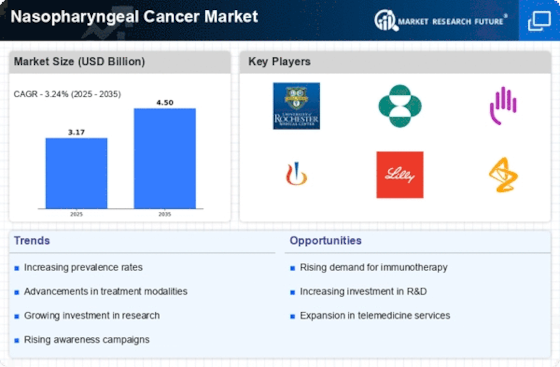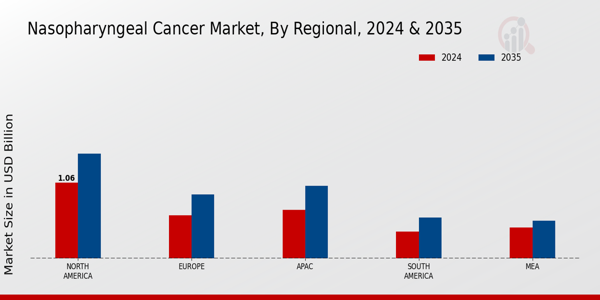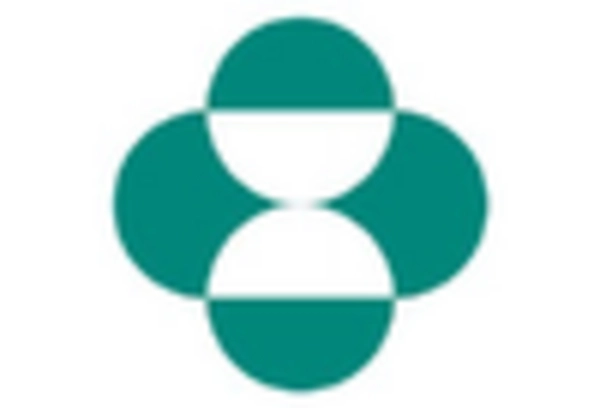Rising Incidence Rates
The rising incidence rates of nasopharyngeal cancer are a pivotal driver for the Nasopharyngeal Cancer Market. Recent statistics indicate that the incidence of this cancer type has been increasing, particularly in certain regions where environmental and genetic factors contribute to its prevalence. This trend necessitates enhanced diagnostic and therapeutic options, thereby stimulating market growth. The World Health Organization has reported that nasopharyngeal cancer is more common in Southeast Asia and North Africa, which may lead to increased demand for specialized treatment facilities and innovative therapies. As awareness of the disease grows, healthcare providers are likely to invest more in research and development, further propelling the market forward.
Expansion of Healthcare Access
The expansion of healthcare access is a vital driver for the Nasopharyngeal Cancer Market. As healthcare systems evolve and improve, more patients gain access to diagnostic and treatment services for nasopharyngeal cancer. This expansion is particularly evident in developing regions, where investments in healthcare infrastructure are increasing. Enhanced access to healthcare services facilitates earlier diagnosis and timely treatment, which are critical for improving patient outcomes. Additionally, telemedicine and digital health solutions are making it easier for patients to consult specialists and receive care, regardless of their geographical location. This trend is likely to lead to a broader market reach and increased demand for nasopharyngeal cancer therapies.
Technological Innovations in Treatment
Technological innovations in treatment modalities are transforming the landscape of the Nasopharyngeal Cancer Market. Advances in radiation therapy, such as intensity-modulated radiation therapy (IMRT) and proton therapy, have shown promising results in improving patient outcomes. These technologies allow for more precise targeting of tumors while minimizing damage to surrounding healthy tissues. Furthermore, the integration of artificial intelligence in diagnostic imaging is enhancing early detection rates, which is crucial for effective treatment. The market is witnessing a surge in investment from pharmaceutical companies focusing on developing novel therapies, including immunotherapy and targeted therapies, which could potentially revolutionize treatment protocols and improve survival rates.
Increased Patient Awareness and Education
Increased patient awareness and education regarding nasopharyngeal cancer are crucial factors driving the Nasopharyngeal Cancer Market. Campaigns aimed at educating the public about the symptoms, risk factors, and importance of early detection are gaining traction. As patients become more informed, they are more likely to seek medical advice and undergo screening, leading to earlier diagnosis and treatment. This shift in patient behavior is likely to result in a higher demand for healthcare services and interventions related to nasopharyngeal cancer. Moreover, healthcare providers are recognizing the importance of patient education in improving treatment adherence and outcomes, further contributing to market growth.
Growing Investment in Research and Development
Growing investment in research and development is a significant driver for the Nasopharyngeal Cancer Market. Pharmaceutical companies and research institutions are increasingly allocating resources to explore new treatment options and improve existing therapies. This trend is evidenced by the rising number of clinical trials aimed at evaluating the efficacy of novel drugs and combination therapies. According to recent data, the number of clinical trials for nasopharyngeal cancer has increased substantially, indicating a robust interest in this area. Such investments not only enhance the understanding of the disease but also pave the way for innovative solutions that could address unmet medical needs, thereby expanding the market.


















Leave a Comment